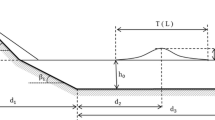Abstract
Wave height transformation plays a crucial role in the investigation of beach deformation and coastal structure design. Parametric wave approach is a widely used method for calculating the transformation of root-mean-square wave height only. The accuracy of existing models depends on wave and beach conditions. Due to the advantage and computational efficiency of parametric wave approach, it would be useful if this method could also be used for modeling mean wave height transformation. This paper focuses on improving the accuracy of existing parametric wave models in modeling root-mean-square wave height transformation under a wide range of wave and beach conditions. Additionally, the paper also explores the applicability of the parametric wave approach in predicting mean wave height transformation by recalibrating coefficients of existing models. Seven parametric wave models are examined and calibrated using both laboratory and field data to predict both root-mean-square and mean wave height transformation. The findings of the study show that the accuracy of root-mean-square wave height transformation prediction is enhanced after modifying coefficients. Furthermore, the paper demonstrates that the parametric wave approach can be effectively employed to predict mean wave height transformation. With adjusted coefficients, parametric wave models estimate mean wave height with great accuracy.
Access this chapter
Tax calculation will be finalised at checkout
Purchases are for personal use only
Similar content being viewed by others
References
Baldock TE, Holmes P, Bunker S, Van Weert P (1998) Cross-shore hydrodynamics within an unsaturated surf zone. Coast Eng 34:173–196. https://doi.org/10.1016/S0378-3839(98)00017-9
Battjes JA, Janssen JPFM (1978) Energy loss and set-up due to breaking of random waves. In: Proceedings of the coastal engineering conference. ASCE, pp 569–587
Battjes JA, Stive MJF (1985) Calibration and verification of a dissipation model for random breaking waves. J Geophys Res Ocean 90:9159–9167. https://doi.org/10.1029/JC090IC05P09159
Duong NT, Tran KQ, Luu LX, Tran LH (2023) Prediction of breaking wave height by using artificial neural network-based approach. Ocean Model 182:102177. https://doi.org/10.1016/j.ocemod.2023.102177
Elbisy MS, Elbisy AMS (2021) Prediction of significant wave height by artificial neural networks and multiple additive regression trees. Ocean Eng 230:109077. https://doi.org/10.1016/j.oceaneng.2021.109077
Hotta S, Mizuguohi M, Isobe M (1982) A field study of waves in the nearshore zone. In: Coastal engineering proceedings, pp 38–57
Kraus NC, Smith MJ (1994) SUPERTANK laboratory data collection project. Tech Rep CERC-94-3, WES, US Army Corps Eng Vols 1 2
Rattanapitikon W, Sawanggun S (2008) Energy dissipation model for a parametric wave approach based on laboratory and field experiments. Songklanakarin J Sci Technol 30:333–341
Rattanapitikon W, Shibayama T (1998) Energy dissipation model for irregular breaking waves. Coast Eng J 40:327–346. https://doi.org/10.1061/9780784404119.007
Rattanapitikon W, Shibayama T (2006) Breaking wave formulas for breaking depth and orbital to phase velocity ratio. Coast Eng J 48:395–416. https://doi.org/10.1142/S0578563406001489
Rattanapitikon W, Tran KQ, Shibayama T (2015) Estimation of Maximum Possible Wave Heights in Surf Zone. Coast Eng J 57:1550001-1-1550001–19. https://doi.org/10.1142/S0578563415500011
Smith ER, Kraus NC (1990) Laboratory study on macro-features of wave breaking over bars and artificial reefs. Tech Rep CERC-90-12, WES, US Army Corps Eng
Southgate HN, Nairn RB (1993) Deterministic profile modelling of nearshore processes. Part 1. Waves and currents. Coast Eng 19:27–56
Thornton EB, Guza RT (1983) Transformation of wave height distribution. J Geophys Res 88:5925–5938. https://doi.org/10.1029/JC088iC10p05925
Thornton EB, Guza RT (1986) Surf zone longshore currents and random waves: Field data and models. J Phys Oceanogr 16:1165–1178
Tran KQ, Duong NT, Luu LX, Tran LH, Rattanapitikon W (2023) Development of novel parametric wave model for irregular wave height transformation. Ocean Eng 278:114493. https://doi.org/10.1016/j.oceaneng.2023.114493
Acknowledgment
We acknowledge Ho Chi Minh City University of Technology (HCMUT), VNU-HCM for supporting this study.
Author information
Authors and Affiliations
Corresponding author
Editor information
Editors and Affiliations
Rights and permissions
Copyright information
© 2024 The Author(s), under exclusive license to Springer Nature Singapore Pte Ltd.
About this paper
Cite this paper
Luu, L.X., Duong, N.T., Tran, L.H., Nguyen, T.Q. (2024). Re-Calibrating of Dissipation Models for Breaking Wave Based on Parametric Wave Approach Using Root-Mean-Square Height and Mean Wave Height. In: Reddy, J.N., Wang, C.M., Luong, V.H., Le, A.T. (eds) Proceedings of the Third International Conference on Sustainable Civil Engineering and Architecture. ICSCEA 2023. Lecture Notes in Civil Engineering, vol 442. Springer, Singapore. https://doi.org/10.1007/978-981-99-7434-4_206
Download citation
DOI: https://doi.org/10.1007/978-981-99-7434-4_206
Published:
Publisher Name: Springer, Singapore
Print ISBN: 978-981-99-7433-7
Online ISBN: 978-981-99-7434-4
eBook Packages: EngineeringEngineering (R0)




